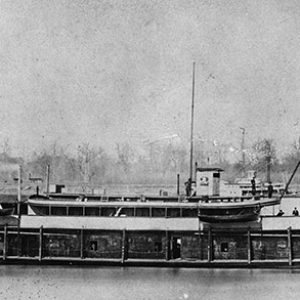calsfoundation@cals.org
USS Marmora
The USS Marmora was a stern-wheel steamboat that served as a U.S. Navy warship in and around Arkansas during the Civil War.
The Marmora was built at the William Latta yard at Monongahela, Pennsylvania, in 1862 for Captain James McDonald, who had it constructed after running another boat of the same name. The 207-ton stern-wheel steamboat was 155 feet long and thirty-three feet and five inches wide, with a four-foot, six-inch draft. The ship’s twin Watson and Monroe boilers sported an innovation, with each having three eleven-inch and three eight-inch flues. Its wheel, which was twenty feet in diameter, worked twenty-four-foot buckets.
The U.S. Navy bought the vessel on September 17, 1862, after McDonald had taken it on a handful of trips. It was commissioned at Carondelet, Missouri, on October 21 and armed with eight 24-pounder cannon, two 12-pounders, and six 14-pounders. Acting volunteer lieutenant Robert Getty was placed in command.
The Marmora steamed toward Vicksburg, Mississippi, immediately after being commissioned and soon attacked and sank several barges at Lake Providence and captured a pair of skiffs while destroying a flatboat farther downstream. The vessel made several runs up the Yazoo River and on December 11 saw several unusual objects afloat in the river. The Marmora fired on one of these (likely a mine), resulting in “a tremendous explosion…which shook the ship from stem to stern,” though it was fifty yards away. The Marmora led three other warships up the Yazoo the next day, and one, the ironclad Cairo, struck a mine and sank. The remaining ships worked with army troops operating against Vicksburg, including the failed attack at Chickasaw Bluff.
The Marmora was part of the naval flotilla that attacked Arkansas Post in January 1863, then participated in a failed army-navy expedition up the Yazoo River. On June 13, guerrillas fired on the Marmora near Eunice, Mississippi, with Getty reporting that they “ordered me with curses to come to and land.” After the Confederates fired on another Union ship the next day, the Marmora cruised up and down the Mississippi over a two-mile stretch, shelling the shore. Getty then landed at Eunice “and burned the entire place, including the railroad depot, with locomotive and care inside, also the large warehouse and, in fact, every house and shed within a mile of the landing.” On June 15, thirty men and two officers from the Marmora boarded the USS Prairie Bird, and the combined force landed at Gaines Landing in Chicot County and burned Batchelder’s plantation after finding evidence that guerrillas were using it as a marshalling location.
The Marmora took part in the Little Red River Expedition in August 1863, holding post at the mouth of the Little Red River as the USS Cricket went up the river to seize the steamboats Tom Sugg and Kaskaskia in the Engagement at West Point. The vessel continued patrolling the Mississippi River, chasing off cotton speculators and seizing cotton “belonging to well-known rebels” in late 1863. In March 1864, it helped fight off a Confederate attack on Yazoo City, Mississippi, and in May its commander reported “the trading establishment at White River as supplying the rebels with clothing, even to cavalry boots” as the Marmora sought to interdict illegal trading activity.
The Marmora continued operating along the Mississippi River until late May 1865, accepting the surrender of a Confederate lieutenant and six soldiers seeking to desert from the army on the Arkansas shore in February. The vessel was sent to Mound City, Illinois, in June and placed in reserve. The Marmora was decommissioned on July 7, 1865, and sold to D. D. Barr for $8,650 on August 17, 1865. There are no records on the Marmora after that sale.
For additional information:
Christ, Mark K. Civil War Arkansas, 1863: The Battle for a State. Norman: University of Oklahoma Press, 2010.
“Marmora I (StwSt).” Dictionary of American Fighting Ships. Naval History and Heritage Command. https://www.history.navy.mil/research/histories/ship-histories/danfs/m/marmora-i.html (accessed January 17, 2019).
Way, Frederick Jr., comp. Way’s Packet Directory. Athens: Ohio University Press, 1994.
Mark K. Christ
Little Rock, Arkansas
 Civil War through Reconstruction, 1861 through 1874
Civil War through Reconstruction, 1861 through 1874 Military
Military Transportation
Transportation USS Marmora
USS Marmora 




Comments
No comments on this entry yet.